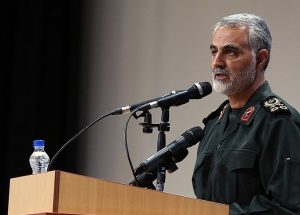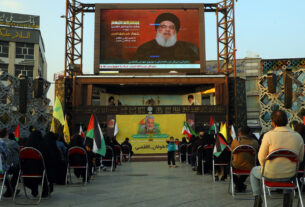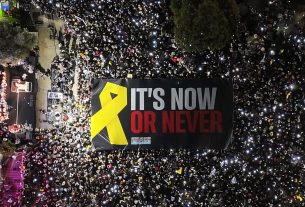{Originally posted to the BESA website}
In 2001, President George Bush launched the Global War on Terror doctrine, articulated in his “overcome darkness with the light of hope” speech at the UN. His successor, Barack Obama, took a different approach to the fight against global terrorism, as characterized by his conciliatory “new beginning” Cairo speech in 2009.
‘);
_avp.push({ tagid: article_top_ad_tagid, alias: ‘/’, type: ‘banner’, zid: ThisAdID, pid: 16, secure: true });
Today, a third approach to the war on terror is unfolding. By ordering the targeted killing of Quds Force chief Qassem Soleimani, Donald Trump essentially declared that no individual or nation responsible for the spread of global terror is immune from American action. If he follows through on that threat with further action, the US might find itself back in its former position of global sheriff.
The killing represents a game change in US foreign policy because neither of Trump’s predecessors would have considered killing an individual as popular and as close to the regime’s inner circle as was Soleimani. He was one of the most prominent personalities to emerge from the 1979 revolution and has been a dominant figure in Iran for decades. Furthermore, he was not categorized by the US as the leader of a terror state but as the commander of a terror force that belongs to a legitimate, if sanctioned and boycotted, state. That distinction was sufficient to render him off-limits in the eyes of Bush and Obama, but not in the eyes of Trump.
The killing of Soleimani will raise already high tensions and increase the probability of further military conflict in the region. The US has demonstrated that it is willing to use its vast resources of hard power against its adversaries once diplomacy and other tools of soft power, like the 2015 Iranian nuclear deal, have failed.
Obama’s legacy was terminated along with Soleimani on January 3. The killing also gave the lie to the false assumption that the US under Trump would not dare launch a military attack against Iran.
The downing by Iran of a US military drone and its attack on the Saudi oilfields sparked anger within the US administration, but the first step toward Soleimani’s killing was in fact taken in April 2019 when the US designated the Quds Force a foreign terrorist organization (FTO). For the first time since 1979, the Islamic Revolutionary Guard Corp (IRGC) was designated by Washington as a terrorist group. With that designation, Trump established a basis for escalation. In an act without precedent in US foreign policy since the Iranian revolution, Trump expressly recognized the “reality where Iran is not only a country sponsoring terrorism, but that its Revolutionary Guards are actively participating in terrorist operations, financing and promoting terrorism.”
Soleimani was personally responsible for the deaths of at least 603 American service members in Iraq since 2003. The US State Department notes that that figure “accounts for 17% of all deaths of US personnel in Iraq from 2003 to 2011, and is in addition to the many thousands of Iraqis killed by the IRGC’s proxies.”
The days of 2001, when the US put together a coalition of European partners to fight the second Iraq war, never seemed so far away. Trump’s new approach reveals the vast gap between himself and the leaders of Europe, many of whom who are warning of danger as Middle East tension revs up. Europe has been struggling to cool tensions over Iran and revive the nuclear “deal” with Tehran that the US abandoned in 2018. UN Security Council Foreign Ministry spokesperson Maria Zakharova said, “This will not lead to anything except an escalation of regional tensions that’ll directly hurt millions of people.” Charles Michel, president of the European Council of EU leaders, called for an end to the “cycle of violence, provocations, and retaliations which we have witnessed in Iraq over the past few weeks…. Too many weapons and too many militias are slowing the process towards a return to healthy daily life for Iraq’s citizens.” German FM Heiko Maas said the US attack did not “make it easier to reduce tensions.”
An interesting response came from Vladimir Putin, who was personally invited by Soleimani to lead the war in Syria. Putin said the attack could “seriously worsen” the situation in the Middle East. Moscow and Tehran are Syrian President Bashar Assad’s patrons, and Putin opposed Trump’s decision to withdraw from the Iran nuclear deal in 2018. When Russia, which plays a key role in the Middle East, expressed its alarm at Soleimani’s death and warned of “serious consequences,” it might have been forecasting action of its own.
Soleimani took charge of the Quds Force in late 1997 and turned out to be one of Iran’s most effective terrorists, outdoing its assorted proxies elsewhere in the region. Lebanese Hezbollah has yet to recover from the killing of Imad Mourniya in 2008. Though Israel was not involved in Soleimani’s killing, it faces a serious threat of “retaliation” by Iranian proxies.
The most immediate challenge for the Americans and Israel is to prepare for the Iranian response. The next will be countering Tehran’s nuclear ambitions, which will only intensify in the wake of Soleimani’s killing. And even without Soleimani on the scene, his well-organized terror machines are here to stay.
(Shay Attias was the founding head (2009-13) of the Public Diplomacy Department at the Israeli Prime Minister’s Office and is a doctoral candidate in international relations at Bar-Ilan University, where he is a lecturer at the Communications School)
‘);
_avp.push({ tagid: article_top_ad_tagid, alias: ‘/’, type: ‘banner’, zid: ThisAdID, pid: 16, onscroll: 10 });




